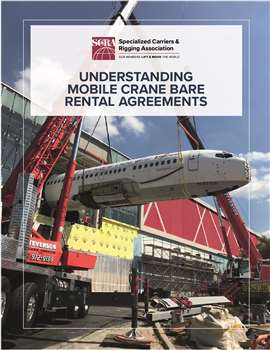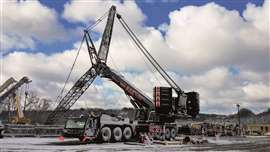SC&RA releases new bare rental contract resource
14 April 2024
In mid-February, SC&RA released a new member resource – Understanding Mobile Crane Bare Rental Agreements – developed to assist members in understanding agreements relevant to common industry work, while also providing a blueprint of sorts that aligns SC&RA and other industry members in collectively working to protect themselves in the bare rental contracts space.
 Understanding Mobile Crane Bare Rental Agreements
Understanding Mobile Crane Bare Rental Agreements
“First and foremost, one of the main goals of our efforts is to bring industry together as much as possible while creating that shared understanding and a common layer of protection,” said SC&RA Senior Vice President, Crane & Rigging Beth O’Quinn. “That was the initial motivator – especially in today’s market and insurance climate – to develop a document, particularly for smaller SC&RA member companies who may not have in-house counsel, that will help them utilize similar contract language which both protects their businesses and allows for safer, more efficient operations moving forward.”
Building off the structure, functionality and success of SC&RA’s Understanding Tower Crane Bare Rental Agreements guide, released in September 2021, O’Quinn indicated that the rationale behind this latest effort was similar. “While many member companies have their agreements, some do not, and they may not appreciate the full impact of the language contained within it on their liability, additional indemnification and more.”
And similar to the Tower Crane guide, the mobile crane document was developed by tapping some of the foremost experts in the industry. “For the Tower Crane document, we worked with several members, but this one was reviewed by our full Governing Committee – thirteen industry professionals,” she noted. “One member who shared the draft with their legal team reported back that, in all their years reviewing contracts, this was the first time they didn’t need to provide any additional feedback.”
According to O’Quinn, Association members representing industry, insurance and legal combed through many rental agreements incorporating different clauses and language to develop the foundation for the document’s core purpose. “A lot of the material was sourced from the Tower Crane Committee – from what we’ve learned – because the language is very similar,” she said. “In that way, we’ve put a magnifying glass on paragraphs that people need to pay close attention to – ‘what to include, what to exclude” type of thing – and we’ve broken them down into different sections.”
Quality insight
Erika Sims, CEO/President at Sims HD, and a member of SC&RA’s Crane & Rigging Governing Group, reiterated the value in the new resource’s ability to build collective strength. “This agreement is important because it not only provides a thorough and extensive overview of what we should be looking at in bare rental contracts, but in the broader sense, we find over and over again that when we align as an industry, we’re stronger. And by utilizing this guide, we can make sure that we’re all on the same page, and therefore better prepared to approach situations where customers want to redline and reject certain portions, which puts us at risk.”
Within the sample clauses section, O’Quinn pointed out that they’ve provided redlined language or identified opportunities. “Again, we’re showing members who might not otherwise understand the nuance within an agreement, ‘… this is what you’ll need to redline,’ because it’s going to have a negative impact on your company. Additionally, we’ve provided similar clauses highlighting language to be included in order to limit the company’s liability.
 The mobile crane document was developed by tapping some of the foremost experts in the industry.
The mobile crane document was developed by tapping some of the foremost experts in the industry.
To that end, she maintained, users will notice the word “contract” doesn’t actually appear in the document. “We want people to realize that what they’re providing is a service, so it’s an agreement, not a contract. We’ve also provided a checklist which allows them to confirm that items such as state-specific indemnification and insurance, inconsistent language, audits, prompt payment, warranties and guarantees and both federal and industry standards have been addressed when required.”
Jeremy Landry, VP at Deep South Crane & Rigging, and chair of SC&RA’s Crane & Rigging Group, echoed O’Quinn. “Often in crane contracts, the language is geared towards ‘maintained and operated.’ That language doesn’t apply to bare rental. This guide gives quality insight into clauses and contracts specific to bare rentals and some that can be eliminated or added in your favor.”
Perfect timing
As a resource, the Understanding Mobile Crane Bare Rental Agreements Guide complements other SC&RA resources, such as the Mobile Crane Assembly/Disassembly Guide, the OSHA Crane Legal Defense Guide and the Crane Accident Investigation Guide – each of which offer SC&RA members an exclusive opportunity to build a safer, more efficient and, ultimately, more productive business. All while backed by the aforementioned strength of the collective.
“All of these guides are examples of the value of an SC&RA membership,” emphasized O’Quinn. “We’ve worked collectively with industry to develop an archive of resources that help member companies comprehend their rights when OSHA comes calling, identify varying risks among different states, be prepared in the event of an accident – or in the case of the new Mobile Crane document, protect themselves against complicated language and nuance while also understanding and limiting their own liabilities.”
And the timing couldn’t be better, according to Billy Smith, EVP at NBIS. “There was a time when a handshake between two parties was all that was needed,” he reflected. “But those days are long gone. Almost everything we do today is under a contract that provides legal protection or guidance in the event of a claim. This guide will educate SC&RA members with the definition of terms, what to look out for and how mobile crane rental agreements may affect your business and insurance costs.”
Kregg Lunsford, President at TNT Crane & Rigging, added, “Well-written terms in any contract are important – to ensure you are protected to the full extent of the law. This document provides both examples of wording to incorporate into your agreements as well as explanations and guidance.”
STAY CONNECTED


Receive the information you need when you need it through our world-leading magazines, newsletters and daily briefings.



